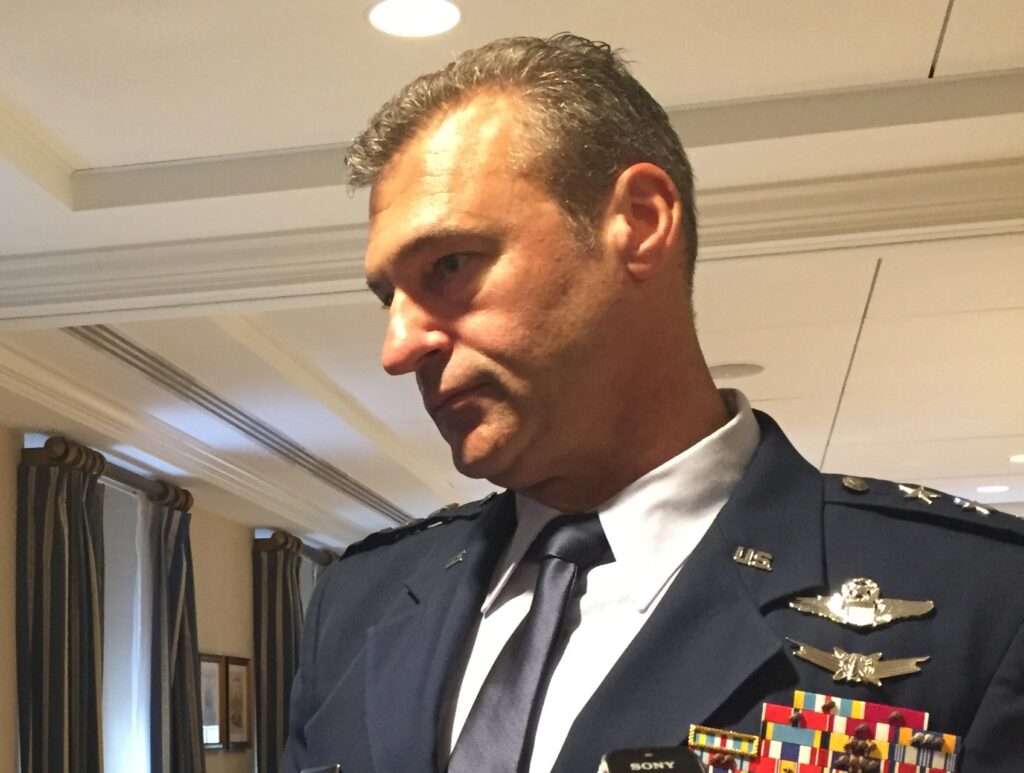
Lt. Gen. Joseph Guastella
WASHINGTON: The Air Force is looking to the other services and the Joint Force for protection of bases and airfields, both abroad and at home, in the face of increased threats from near-peer adversaries, says Lt. Gen. Joseph Guastella, deputy chief of operations.
“I would argue, that’s the tax. If you want airpower, if you want space power, then you have to be able to defend it,” he told the Mitchell Institute today.
In the “wars of our generation over the last few decades, airpower has been in many cases viewed as a supporting service,” Guastella explained. “We provide close air support. We provide airlift. We provide ISR. We provide personnel recovery. We provide airborne electronic warfare. And we provide command and control, by the way. And, as Department of the Air Force, we are expected to provide GPS, satellite communications, missile warning, and, of course, intelligence from space. Those are all requirements asked of the Air Force, and the Department of Air Force.”
“What requirement does the Air Force levy upon the Joint Force? I’ll tell you, it’s called protection,” he said. This includes protection of airfields, population centers where air forces are forward deployed, ports and critical infrastructure, he explained. And it includes not just physical protection, but defense against future threats such as hypersonic missiles.
Guastella argued that support from the other services is warranted because air power is critical to the joint fight. “Every combatant command comes online and says, ‘We need air power’,” he said. “Without a doubt, airpower is uniquely, and I would say disproportionately, in demand against the full range of military operations.”
As Breaking D readers may recall, Air Force Chief of Staff Gen. Charles Brown told the Senate Armed Services Committee in written answers for his May 7 confirmation hearing that the time has come for a new roles and missions study, in part to sort out base protection. “With the growing threat and joint operations from more distributed locations, the roles and missions for base defense—from the fence line to all the way up to hypersonics—is worthy of discussion and review,” he said.
The high demand for air power is part of the dilemma the Air Force faces as it tries to balance current readiness, which requires extremely expensive maintenance of old platforms and systems, against the need for recapitalization and investment in future systems, Guastella explained.
“The cost of maintaining legacy weapon systems increases over time. And, you know, think about the health care that an 80- or 90-year-old needs. It’s probably a lot more expensive health care than a 20-year-old needs,” he said. “And so that’s why it’s a constant struggle to to address the demands that our nation asks of us — all the combatant commands — but at the same time maintain fleets that are viable, and then also eventually modernize.”
“I’m happy to tell you which force elements, which squadrons to get rid of, if you can tell me which missions we no longer need to do for the nation,” he added.
Guastella demurred, however, to comment specifically on last week’s report from the congressionally-mandated National Commission on Military Aviation Safety. It found that more than 6,000 military aviation accidents across all of the services killed 224 pilots or aircrew, destroyed 186 aircraft and cost $11.6 billion between 2013 and 2018. None of those were during combat operations. The report blamed :the extremely high ops tempo; rushed and often truncated training regimes; maintenance staff being dual-hatted with other jobs, such as base security; and lack of consistent funding, due to the continued reliance of Congress and the White House on continuing resolutions because of inability to agree on annual defense appropriations.
Saying he hadn’t had a chance to read the full study, Guastella said the issues are being addressed by Air Force leadership. “We’re gonna digest this report, and we’re gonna figure out what what adjustments if any, we need to make from what we’re doing. But we take it very, very seriously.”
“As the report says, pilots need to fly and maintainers need to maintain—which is true for the airlines as well as the military,” Mark Gunzinger, head of future concepts at the Mitchell Institute told me in an email. “The combination of reduced training hours, fewer cockpits, an aging force that is increasingly expensive to maintain and operate, growing operational demand, and flat budgets is a bad mix.”
That said, he noted that the bulk of the accidents chronicled by the study were attributable to the Marines and the Navy. “The relatively flat USAF mishap rates are a credit to the service’s leadership,” he said.
Teal Group’s Richard Aboulafia agreed that there are a number of factors contributing to the problems, but that funding is an issue — not only flat budgets, but also the funding choices made by the services.
“This (aviation study) is a superb report, and it lays out the key issues. Clearly, there are some factors that can be modified more easily than others, particularly those dealing with process,” he said in an email. “But the report is quite clear that funding is a big issue. It’s a very useful reminder that it’s foolish to prioritize cash for new weapons over flying, training, and sustainment costs.”
Move over FARA: General Atomics pitching new Gray Eagle version for armed scout mission
General Atomics will also showcase its Mojave demonstrator for the first time during the Army Aviation Association of America conference in Denver, a company spokesman said.


























